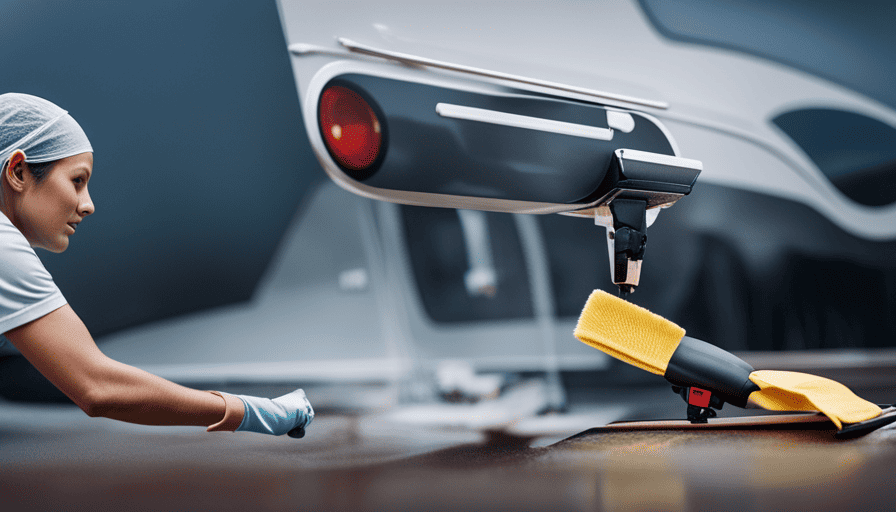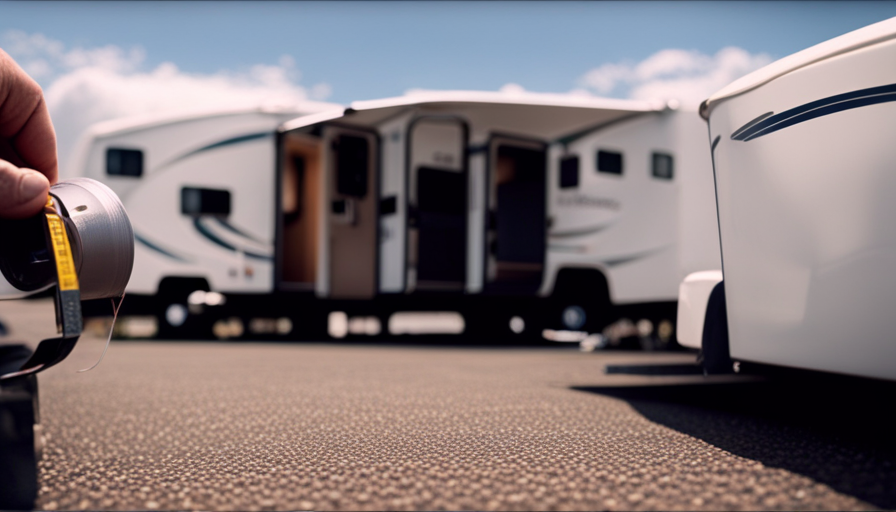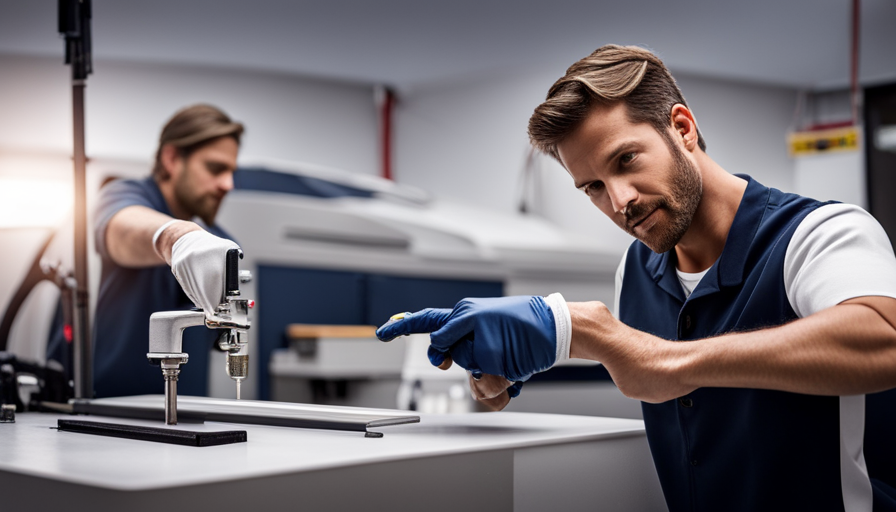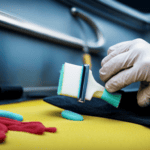Beginners Guides
How To Clean Fiberglass Camper

I will always remember the initial journey I embarked on with my fiberglass camper, hitting the open highways. The feeling of liberation and adventure was thrilling. However, it didn’t take long for me to recognize the importance of maintaining my camper’s cleanliness and optimal condition to extend its durability and preserve its glossy appearance. It was at this point that I uncovered the techniques for effectively cleaning fiberglass campers.
In this article, I will share with you my tried and true methods for cleaning fiberglass campers. From gathering the necessary supplies to polishing the surface, I will guide you through each step of the process. I’ll even share a few tips on how to treat stubborn stains and prevent buildup.
So, whether you’re a seasoned camper or just starting out, this article will equip you with the knowledge and tools you need to keep your fiberglass camper looking its best. Get ready to hit the road with a camper that shines like new!
Key Takeaways
- Rinse off loose dirt and debris from the camper’s surface before cleaning.
- Use a mild detergent or a cleaning solution specifically designed for fiberglass surfaces.
- Pay extra attention to dirty or stained areas and scrub in circular motions to remove grime and dirt.
- Rinse off the cleaning solution thoroughly and dry the fiberglass surface with a clean cloth or towel.
Gather your cleaning supplies
Before you dive into cleaning your fiberglass camper, make sure you’ve gathered all your cleaning supplies. Cleaning a fiberglass camper requires a specific set of cleaning tips and the best cleaning products to ensure a thorough and successful cleaning session.
To begin, you’ll need a bucket filled with warm water, a soft sponge or brush, a mild detergent specifically designed for fiberglass surfaces, a microfiber cloth, and a hose with a spray nozzle. These supplies will help you effectively clean your camper without causing any damage to the fiberglass material.
Start by rinsing off any loose dirt and debris from the surface of your camper using the hose with a spray nozzle. This will help remove any large particles that could potentially scratch the fiberglass during the cleaning process.
Once the loose dirt is removed, mix a small amount of the mild detergent with warm water in the bucket. Dip the sponge or brush into the soapy water and gently scrub the fiberglass surface in circular motions. Pay extra attention to areas that are particularly dirty or stained.
After thoroughly cleaning the entire surface, rinse off the soapy residue using the hose. Make sure to use a gentle water pressure to avoid any potential damage. Once the camper is rinsed, use a microfiber cloth to dry the surface. This will prevent any water spots or streaks from forming on the fiberglass.
With your cleaning supplies ready, you can now move on to the next step of cleaning your fiberglass camper: rinsing off any loose dirt and debris.
Rinse off any loose dirt and debris
First, make sure to grab a hose and give your fiberglass beauty a thorough rinse, removing any pesky dirt or debris that may have accumulated. This step is crucial as it prepares the surface for the cleaning process.
Cleaning fiberglass campers requires a specific technique to ensure the removal of stubborn stains while protecting the integrity of the material.
Start by directing the hose towards the camper, focusing on areas that appear dirty or have visible debris. Use a high-pressure setting to effectively dislodge any stuck-on dirt. Move the hose in a sweeping motion, covering the entire surface of the camper. Pay extra attention to corners, edges, and crevices where dirt tends to accumulate.
The rinse should remove loose dirt and debris, making the subsequent cleaning process more effective. Additionally, it allows you to identify any persistent stains that may require extra attention. If you notice stubborn stains, take note of their location for targeted cleaning later on.
With your camper now rinsed and ready, it’s time to prepare a cleaning solution that will effectively tackle those stubborn stains. Transitioning into the next section, let’s move on to preparing a cleaning solution that will restore your fiberglass camper’s pristine appearance.
Prepare a cleaning solution
Now that your fiberglass beauty is rinsed and ready, it’s time to whip up a powerful cleaning solution that’ll have your camper looking brand new.
When it comes to cleaning solutions for fiberglass, there are a variety of alternatives to choose from. If you prefer eco-friendly options, look no further than vinegar and water. Mix equal parts of white vinegar and water in a spray bottle and shake well. Vinegar’s a natural disinfectant and it’ll help remove any stubborn stains or dirt.
Another eco-friendly option is baking soda and water. Create a paste by mixing baking soda with a small amount of water and apply it to the fiberglass surface. Let it sit for a few minutes before scrubbing gently with a sponge or soft brush. This paste’s effective at removing tough stains and grease.
Transitioning into the next section, applying the cleaning solution to the fiberglass surface is the next step in restoring your camper’s shine.
Apply the cleaning solution to the fiberglass surface
To give your fiberglass beauty a sparkling makeover, it’s time to unleash the cleaning solution onto its smooth surface.
When it comes to cleaning fiberglass, there are a few alternatives to consider, especially if you prefer to use natural or homemade solutions. One option is to mix equal parts of baking soda and water to create a paste. This paste can be applied to tough stains on fiberglass and left to sit for a few minutes before scrubbing it off.
Another alternative is to use vinegar diluted with water. This mixture can help break down dirt and grime on the surface of the fiberglass camper.
Once you’ve chosen the cleaning solution that suits your preferences, it’s time to apply it. Start by wetting the fiberglass surface with water to prepare it for the cleaning process. Then, using a sponge or a soft brush, apply the cleaning solution to the fiberglass. Make sure to cover the entire surface, paying extra attention to any stubborn stains or dirt spots. Gently scrub the surface in circular motions to remove any grime or dirt.
Transitioning into the next section about using a soft brush or sponge to scrub the surface, you’ll want to ensure that you’ve thoroughly cleaned the fiberglass.
Use a soft brush or sponge to scrub the surface
For an effective and efficient cleaning process, grab a soft brush or sponge to effortlessly scrub away any dirt or grime from the fiberglass surface.
When it comes to choosing between a soft brush and a sponge, both can be effective in cleaning fiberglass. However, it’s important to consider the condition of your fiberglass surface. If the surface is delicate or prone to scratching, a soft brush is the better option. The bristles of a soft brush are gentle enough to remove dirt without causing any damage. On the other hand, if the surface is more durable, a sponge can also be used. A sponge is great for removing stubborn stains or grime, as it has a slightly abrasive texture that can provide a deeper clean.
Before starting the scrubbing process, make sure to apply the appropriate cleaning solution to the fiberglass surface. There are various cleaning solutions available in the market specifically designed for fiberglass surfaces. It’s important to choose a cleaning solution that’s gentle and safe for use on fiberglass. Read the instructions on the product carefully and follow them accordingly.
Once the cleaning solution is applied, use the soft brush or sponge to scrub the surface in a circular motion. This will help to effectively remove any dirt or grime that may have accumulated on the fiberglass.
After thoroughly scrubbing the surface, it’s time to rinse off the cleaning solution with water. This step is crucial in removing any residue left behind from the cleaning solution. Use a hose or bucket of water to rinse the fiberglass surface until all the cleaning solution has been washed away. This will leave your fiberglass camper looking clean and shiny, ready for your next adventure.
Rinse off the cleaning solution with water
When you’ve finished the scrubbing process, it’s time to give your fiberglass beauty a refreshing shower to wash away the remnants of the magic elixir you’ve applied.
Using a hose for rinsing, clean the fiberglass camper effectively, including the hard to reach areas. Make sure to adjust the pressure of the water to a gentle stream to avoid any damage to the surface.
Start by spraying water from top to bottom, ensuring that every inch of the camper is thoroughly rinsed. Pay close attention to the corners, crevices, and any other hidden spots where dirt and grime tend to accumulate.
To ensure a deep and thorough clean, use a mild detergent specifically designed for cleaning fiberglass surfaces. This will help to remove any remaining dirt, stains, or residue without causing any harm to the delicate fiberglass. Dilute the detergent in a bucket of water according to the manufacturer’s instructions, and then use a soft brush or sponge to apply the soapy solution all over the camper. Scrub gently in circular motions, focusing on any stubborn spots that require extra attention.
Once the entire surface has been rinsed off with clean water, it’s time to move on to the next step – drying the fiberglass surface with a clean cloth or towel. But before we dive into that, let’s make sure the rinsing process is complete and all the soap has been washed away.
Only then can we proceed to the next stage of this cleaning journey.
Dry the fiberglass surface with a clean cloth or towel
After giving your fiberglass beauty a refreshing shower, gently dry the surface with a clean cloth, revealing its flawless shine. Drying the fiberglass properly is crucial to prevent water spots or streaks from forming.
To ensure a thorough drying process, you can use a few different techniques. Firstly, you can simply use a clean, dry cloth or towel to gently pat the surface dry. This method is effective for small areas or if you’re working on a smaller camper.
Alternatively, you can use a microfiber cloth to absorb any remaining moisture, ensuring a streak-free finish. Another option is to use a hairdryer on a low heat setting to blow-dry the fiberglass. This technique is especially useful for larger campers or hard-to-reach areas.
If you prefer to use alternative cleaning solutions, such as vinegar or baking soda, to clean your fiberglass camper, it’s important to still follow the same drying techniques. The vinegar or baking soda can be diluted with water and used as a cleaning solution, but it’s crucial to rinse off the solution thoroughly and dry the surface properly afterwards. This will prevent any residue from being left behind.
Once the fiberglass surface is dry, you can move on to treating any stubborn stains with a specialized fiberglass cleaner. This will ensure that your camper is not only clean but also free from any tough stains that may have accumulated over time.
Treat any stubborn stains with a specialized fiberglass cleaner
Once the drying process is complete, it’s time to tackle those stubborn stains with a specialized cleaner. Fiberglass surfaces can sometimes develop tough stains that require a little extra attention. Thankfully, there are several fiberglass cleaner alternatives available that can effectively remove these stubborn marks.
One option is to use a commercial fiberglass stain remover, which is specifically designed to target and eliminate tough stains on fiberglass surfaces. These cleaners often contain powerful ingredients that can break down and dissolve the stains, leaving your fiberglass camper looking clean and refreshed.
If you prefer a more DIY approach, you can also create your own fiberglass stain remover using common household items. One popular homemade solution is a mixture of baking soda and vinegar. Simply create a paste by combining these two ingredients and apply it to the stained area. Allow the paste to sit for a few minutes before scrubbing it gently with a soft cloth or sponge. This natural solution can be highly effective in removing stains without causing any damage to the fiberglass surface.
Once you have successfully treated the stubborn stains, it’s time to move on to the next step: polishing the fiberglass surface to restore its shine. Transitioning into this next section, it’s important to note that polishing is the final touch that will give your fiberglass camper that showroom-worthy appearance.
Polish the fiberglass surface to restore its shine
To bring back the dazzling brilliance of your fiberglass surface, it’s time for you to polish it and watch it gleam like never before. Restoring the shine to your fiberglass camper is an important step in maintaining its overall appearance and longevity.
Before you begin, make sure the surface is clean and free of any dirt or debris. Once the surface is prepped, apply a high-quality fiberglass polish using a soft cloth or buffer. Work in small sections, applying the polish in a circular motion. This will help to evenly distribute the product and ensure a smooth finish.
As you polish, you’ll start to see the shine return to the fiberglass surface. Continue this process until the entire camper has been polished. Once finished, take a step back and admire the renewed luster of your fiberglass.
Moving forward, regularly maintain and clean your fiberglass camper to prevent buildup and prolong its lifespan.
Regularly maintain and clean your fiberglass camper to prevent buildup and prolong its lifespan
Regularly maintaining and cleaning your fiberglass camper can significantly extend its lifespan, ensuring that it remains in good condition for years to come. Did you know that regular maintenance can reduce the risk of costly repairs by up to 50%?
To effectively maintain your fiberglass camper, it’s important to establish a regular cleaning routine. Start by removing any loose dirt or debris from the exterior using a soft brush or cloth. Next, mix a mild detergent with water and gently scrub the surface to remove any grime or stains. Rinse thoroughly with clean water and dry with a soft towel.
It’s also crucial to inspect the camper regularly for any signs of damage, such as cracks or chips in the fiberglass. Promptly repair any issues to prevent further damage. Additionally, applying a protective wax or sealant can help prevent buildup and maintain the camper’s shine.
By following these maintenance steps and preventing buildup, you can ensure that your fiberglass camper remains in top condition for years to come.
Frequently Asked Questions
Can I use any type of cleaning solution on the fiberglass surface?
Yes, it’s important to use non-abrasive cleaners when cleaning a fiberglass surface. Using alternative cleaning methods can help maintain the integrity of the fiberglass and prevent any damage. Harsh cleaning solutions can cause scratches and reduce the lifespan of the camper.
It’s recommended to use mild soap or specialized fiberglass cleaners. Always follow the manufacturer’s instructions and test any new cleaning product on a small, inconspicuous area before applying it to the entire surface.
How often should I clean my fiberglass camper?
I recommend cleaning and waxing your fiberglass camper at least twice a year to maintain its appearance and protect the surface. Regular cleaning is important to remove dirt, grime, and road debris that can accumulate over time.
When cleaning, use mild soap and water or specialized fiberglass cleaners that are safe for the surface. For waxing, choose a high-quality automotive wax specifically designed for fiberglass campers to provide maximum protection and shine.
What should I do if the cleaning solution doesn’t remove stubborn stains?
If the cleaning solution doesn’t remove stubborn stains, don’t worry! There are alternative cleaning methods you can try.
One option is to use a mixture of baking soda and water to create a paste. Apply the paste to the stains, let it sit for a few minutes, then scrub it off with a soft brush.
If that doesn’t work, you can also consider professional cleaning services that specialize in fiberglass camper cleaning. They have the expertise and equipment to tackle even the toughest stains.
Can I use a power washer to rinse off the cleaning solution?
Yes, you can use a power washer to rinse off the cleaning solution from your fiberglass camper. However, it’s important to prioritize power washer safety. Make sure to use a low-pressure setting to avoid damaging the fiberglass surface.
Additionally, consider using alternative cleaning methods if the power washer isn’t effective in removing stubborn stains. These may include using a soft brush or sponge with a mild detergent or trying specialized fiberglass cleaners.
Are there any specific maintenance tips to keep the fiberglass camper in good condition?
To keep your fiberglass camper in great condition, it’s important to follow a regular maintenance schedule. This includes cleaning the exterior regularly to remove dirt, grime, and any potential stains. Using the best cleaning products specifically designed for fiberglass, such as non-abrasive cleaners, will ensure a thorough yet gentle cleaning.
Additionally, it’s essential to inspect the camper for any cracks or damage and address them promptly to prevent further issues.
Can the Same Cleaning Methods Be Used for Cleaning Fiberglass Campers and Camper Cushions?
When it comes to cleaning fiberglass campers and camper cushions, it’s essential to remember that different materials require different methods. While fiberglass can be cleaned with gentle soapy water and a soft cloth, camper cushions might need a more delicate approach. To maintain the quality of your camper cushions, vacuuming and spot cleaning are recommended. For a deeper clean, consider using a fabric cleaner specifically designed for camper cushions. These cleaning tips for camper cushions will ensure both your fiberglass camper and cushions stay in great condition.
Conclusion
Well, folks, there you have it! Cleaning your fiberglass camper can be quite the adventure, but with the right supplies and techniques, it’s a breeze.
From gathering your cleaning supplies to polishing the surface, we’ve covered it all.
So, hop on board and give your camper the pampering it deserves. With regular maintenance and cleaning, you’ll ensure a smooth and shiny ride for years to come.
Happy cleaning, and may your fiberglass camper always sparkle like a diamond in the sun!
Jason is the author of Laienhaft, a blog for all things outdoor and camping. If you’re looking for the best tent to take on your next camping trip, or need some advice on how to get started with recreational camping, Jason has you covered. He’s also an expert on survival skills – if you’re ever lost in the wilderness, he’s the guy you want to find!
Beginners Guides
How To Measure Camper Length

The size of a camper, similar to the winding road ahead, can sometimes be a challenge to measure. But fear not, adventurers! I am here to help as your trusty guide, excited to unveil the secrets of measuring a camper’s length.
Picture this: you’re embarking on a thrilling camping trip, and you need to determine the size of your faithful companion, your camper. Whether you’re looking to upgrade your rig or simply find the perfect campsite, accurate measurements are your compass in this vast world of camping.
So, grab your measuring tape and let’s dive in! In this article, I’ll walk you through the step-by-step process of measuring camper length, from gathering the necessary tools to recording and double-checking your measurements. Together, we’ll unlock the key to selecting the ideal campsite and ensure a smooth and delightful camping experience.
So, my fellow explorers, let’s embark on this journey of measurement mastery!
Key Takeaways
- Accurate measurements of a camper’s length are important for various reasons, including choosing the right campsite and accessories, ensuring proper navigation and weight distribution.
- The tools needed to measure camper length include a tape measure, notepad, pen, and a ladder.
- To measure the length of a camper, start at the front edge and measure the exterior length from front to back, including any protruding parts. Then, measure the interior length by removing obstacles and measuring from the back to the front wall. Consider the width and height of the interior space as well.
- When measuring attachments such as awnings or bike racks, measure them in their fully extended or maximum position as they can affect the overall length of the camper.
Importance of Measuring Camper Length
You should understand the importance of measuring the length of your camper to ensure proper fit and avoid any potential issues. Accurate measurements are crucial when it comes to finding the right size for your camper.
Knowing the exact length of your camper has several benefits. Firstly, it allows you to choose the appropriate campsite or parking space. Some campsites have size restrictions, and knowing your camper’s length ensures that you won’t encounter any unexpected limitations.
Secondly, accurate measurements help you select the right accessories and equipment for your camper. Whether it’s a cover, awning, or bike rack, knowing the length of your camper ensures a perfect fit and avoids wasted time and money.
Additionally, understanding the length of your camper helps with navigation and maneuvering. It allows you to plan your route effectively, avoiding low bridges or narrow roads.
Lastly, accurate measurements contribute to the overall safety and stability of your camper. By knowing its length, you can distribute weight evenly and avoid any imbalance issues.
So, now that you understand the importance of accurate measurements, let’s move on to the next step: gathering the necessary tools.
Gather the Necessary Tools
Grab your trusty tape measure and prepare to embark on a journey of discovery as you delve into the world of quantifying the dimensions of your beloved home on wheels. When it comes to measuring the length of your camper, accuracy is key. A slight miscalculation can result in costly mistakes when it comes to parking or fitting your camper into storage spaces.
To ensure precise measurements, gather the necessary tools for the job. Here are a few items you’ll need:
- A tape measure with both metric and imperial units for versatility.
- A notepad and pen to jot down measurements for reference.
- A sturdy step ladder to reach the higher points of your camper.
Now that you have the tools at your disposal, it’s important to emphasize the significance of accuracy. Even the smallest measurement mistake can lead to difficulties down the road. It’s common for people to overlook small details or make assumptions, resulting in inaccurate measurements. By taking the time to measure your camper correctly, you can avoid unnecessary hassles and ensure a smooth journey.
With the tools in hand and the importance of accuracy in mind, it’s time to move on to the next step: locating the starting point for measurement.
Locate the Starting Point
Before embarking on the journey of accurately quantifying the dimensions of your mobile home, it’s crucial to locate the starting point for measurement, setting the foundation for a meticulous assessment. To ensure accuracy, it is important to use a measuring tape and a level to guarantee precise measurements. Here is a handy table to help guide you through the process:
| Tool | Purpose |
|---|---|
| Measuring tape | Determines length accurately |
| Level | Ensures a straight and level starting point |
To locate the starting point, position yourself at the front of the camper. Place the measuring tape at the very front edge, ensuring it is flush against the wall. Extend the tape along the entire length of the camper until you reach the end. Take note of the measurement and mark it as the starting point.
By using this measuring technique, you can establish an accurate starting point for measuring the exterior length of your camper. This will provide a solid foundation for the subsequent section on how to measure the exterior length without missing any crucial details.
Measure the Exterior Length
Start by using a measuring tape and level to accurately determine the dimensions of your mobile home, ensuring a straight and level starting point. Did you know that the average exterior length of a mobile home is around 60 feet?
To measure the exterior length of your camper, begin at the front of the trailer and extend the measuring tape all the way to the back. Make sure to measure from the outermost points, including any protruding parts like bumpers or hitches. This will give you an accurate measurement of the overall length of your camper.
Knowing the exterior length of your camper is essential when considering parking and storage options. It will help you determine whether your mobile home will fit in a designated space or if you need to make any adjustments. Additionally, understanding the exterior length can give you an idea of the interior space and storage capacity of your camper.
Next, we will move on to measuring the interior length of your mobile home. By accurately measuring both the exterior and interior dimensions, you will have a comprehensive understanding of the size and layout of your camper, allowing you to make informed decisions when it comes to planning your camping adventures.
Measure the Interior Length
Once you’ve determined the exterior dimensions of your mobile home, it’s time to explore the spacious interior and uncover the true length of your camper.
To accurately measure the interior length, you’ll need to utilize specific measuring techniques and take into account the overall dimensions of the living space.
Start by removing any furniture or belongings that might obstruct your measurements. Use a tape measure to measure the distance from the back wall to the front wall of the camper. Make sure to measure from the inside of the walls to get an accurate measurement.
Additionally, measure the width and height of the interior space to capture a complete understanding of the dimensions. Take note of any irregularities or protrusions, such as cabinets or appliances, that may affect the measurements.
Once you have gathered all the necessary measurements, you can confidently determine the interior length of your camper. With this information, you can now consider any additional attachments that may extend the overall length of your camper, such as awnings or bike racks.
Consider Any Additional Attachments
When it comes to measuring the interior length of a camper, there are a few things you need to consider. In my experience, it’s important to take into account any additional attachments that may affect the overall length. These attachments could include things like awnings, bike racks, or spare tire carriers. They can add a few extra feet to the camper’s length, so it’s crucial to measure with them in mind.
To ensure measuring accuracy, I recommend taking the measurements with the attachments fully extended or in their maximum position. This will give you the most accurate measurement of the camper’s total length.
When measuring, it’s also helpful to use a nested bullet point list to keep track of the different measurements and attachments:
-
Measure the interior length of the camper without any attachments
-
Extend or position the attachments to their maximum length
-
Measure the additional length added by each attachment
By following these steps and considering any additional attachments, you can ensure that your measurements are precise and accurate. This is crucial when it comes to planning for storage or determining if the camper will fit in a specific space.
Now that we’ve measured the interior length and considered any additional attachments, it’s time to record and double-check the measurements.
Record and Double-Check the Measurements
To ensure absolute precision, make sure to jot down and meticulously cross-reference the measurements you’ve taken, capturing every minute detail that will determine the perfect fit for your camper. Double-checking measurements is essential to avoid common measurement mistakes that could lead to an ill-fitting camper.
One common mistake is failing to record measurements accurately, which can result in a camper that is too big or too small for your needs. Another mistake is not double-checking the measurements against the camper’s specifications, which can lead to costly errors.
It’s also important to consider any additional attachments you may have on your camper, such as awnings or bike racks, and factor those into your measurements.
By taking the time to double-check your measurements and consider all attachments, you can ensure that your camper will fit perfectly at any campsite you choose. This will allow you to make the most of your camping experience without any unexpected surprises.
Use the Measurements for Campsite Selection
Now that you have the precise measurements, you can easily find the perfect campsite that will accommodate your camper without any surprises. It’s important to consider the campsite amenities and campground regulations when making your selection.
Start by looking for campsites that offer the amenities you need, such as electrical hookups, water connections, and dump stations. Some campgrounds even have amenities like swimming pools, playgrounds, and laundry facilities.
Make sure to check if there are any restrictions on camper length or vehicle size at the campsite you’re considering. This will ensure that your camper fits within the designated space and that you won’t be turned away upon arrival.
Additionally, familiarize yourself with any campground regulations regarding noise levels, pet policies, and quiet hours to ensure a peaceful and enjoyable camping experience.
By considering these factors, you can find a campsite that meets your needs and provides a comfortable stay for you and your camper.
Now, let’s move on to some tips for choosing the right campsite.
Tips for Choosing the Right Campsite
Discover your perfect campsite by following these tips and create memories that will last a lifetime. When choosing a campsite location, there are a few key factors to consider. First, think about the amenities that are important to you. Are you looking for a campsite with electricity and running water, or are you more interested in a secluded spot off the beaten path? Consider what facilities are available at each campsite and choose one that meets your needs.
To help you make a decision, here is a handy table that compares different campsites based on their amenities:
| Campsite | Electricity | Running Water | Picnic Tables | Restrooms |
|---|---|---|---|---|
| Campsite A | Yes | Yes | Yes | Yes |
| Campsite B | No | Yes | No | Yes |
| Campsite C | Yes | No | Yes | No |
| Campsite D | No | No | No | No |
By comparing the amenities offered at each campsite, you can easily find the one that suits your preferences. Once you have chosen the perfect campsite, you can focus on enjoying a smooth camping experience.
Enjoy a Smooth Camping Experience
Having a hassle-free camping experience is possible with proper planning and preparation. When it comes to enjoying a smooth camping experience, having the right camping gear is essential. Make sure to check your camping equipment before heading out, ensuring that everything’s in good working condition. This includes your tent, sleeping bags, cooking utensils, and any other gear you might need.
Another important aspect of a smooth camping experience is campfire safety. Before starting a campfire, check the rules and regulations of the campsite regarding fire safety. Always choose a designated fire pit and clear the area around it from any flammable materials. Keep a bucket of water nearby and never leave the fire unattended. It’s also important to fully extinguish the fire before leaving the campsite or going to sleep.
In addition to these tips, it’s helpful to have a camping checklist to ensure you’ve got everything you need. This’ll help you avoid forgetting any essential items and make your camping experience more enjoyable. Lastly, don’t forget to pack some entertainment options like board games or a deck of cards to keep yourself and your fellow campers entertained during downtime.
With these tips in mind, you’ll be well-prepared for a smooth and enjoyable camping experience.
Frequently Asked Questions
How do I measure the height of my camper?
To measure the height of your camper, start by finding a level surface and park your camper on it. Use a measuring tape to measure from the ground to the highest point of your camper’s roof. It’s important to note that different types of campers may require different measuring techniques. For example, pop-up campers may need to be fully extended before measuring. Knowing how to measure camper width is also crucial for a complete understanding of your camper’s dimensions.
Can I measure the camper length by using a tape measure alone?
Yes, you can measure the camper length using a tape measure alone. To determine the camper size accurately, start by extending the tape measure from the front to the rear of the camper, measuring from the outermost points. Make sure to include any additional length from attachments like bumpers or spare tires.
By measuring the camper width as well, you can get a comprehensive understanding of its dimensions and make informed decisions when it comes to storage or transportation.
Should I include the hitch in the camper length measurement?
Yes, it’s essential to include the hitch in the camper length measurement. The hitch weight plays a crucial role in how the camper handles during travel. By accurately measuring the entire length of the camper, including the hitch, you can determine the weight distribution and ensure safe towing.
Accurate measurements are vital for determining the hitch weight and ensuring that your camper is properly balanced and secure on the road.
Are there any specific tools or techniques to measure the interior length accurately?
To measure the interior length of a camper accurately, I suggest using a tape measure and a straightedge. Start by removing any obstructions, such as furniture or curtains, to get an unobstructed measurement.
Place the tape measure at one end of the interior and extend it to the other, following the contours of the walls. Make sure to measure both the widest and narrowest points to get an accurate understanding of the camper’s width.
This technique ensures precise measurements for determining the interior length of your camper.
What are some common mistakes people make when measuring their camper length?
Common misconceptions about camper length measurement often stem from not taking into account certain factors.
One common mistake is not considering the protrusions, such as awnings or bike racks, that may add to the overall length.
Another mistake is not properly measuring the tongue or hitch, which can significantly impact the total length.
To accurately measure the length of a camper, it’s important to take these factors into consideration and use a measuring tape to get precise measurements.
Conclusion
In conclusion, accurately measuring your camper length is crucial for a seamless camping adventure. By gathering the necessary tools, locating the starting point, and measuring both the exterior and interior length, you can ensure precise measurements.
Recording and double-checking these measurements will further guarantee accuracy. Utilizing these measurements for campsite selection will allow you to find the perfect spot for your camper. Remember to consider tips for choosing the right campsite to enhance your overall experience.
So, start measuring and embark on a marvelous camping journey!
Jason is the author of Laienhaft, a blog for all things outdoor and camping. If you’re looking for the best tent to take on your next camping trip, or need some advice on how to get started with recreational camping, Jason has you covered. He’s also an expert on survival skills – if you’re ever lost in the wilderness, he’s the guy you want to find!
Beginners Guides
How To Move A 5th Wheel Camper With A Tractor

Transporting a 5th wheel camper with a tractor can be challenging, similar to herding cats, but with the right knowledge and preparation, it can be done smoothly. Like a conductor guiding an orchestra, I am here to provide a comprehensive guide on safely and efficiently moving your 5th wheel camper with a tractor.
From assessing your tractor’s capabilities to properly hitching and connecting the camper, securing it for transportation, and maneuvering with precision, I will walk you through each crucial aspect of the process.
We will cover everything from checking the connection and brakes to driving slowly and steadily, taking breaks, and following safety regulations.
By the end of this article, you’ll be ready to tackle the challenge of moving your 5th wheel camper with confidence and ease.
Key Takeaways
- Assess tractor’s capabilities and attachments for towing stability and control.
- Use a hitch specifically designed for 5th wheel campers for secure and stable connection.
- Practice in an open area to improve maneuverability skills.
- Plan the route and consider obstacles before starting the journey.
Assess Your Tractor’s Capabilities and Attachments
Before you can begin moving a 5th wheel camper with a tractor, it’s important to assess your tractor’s capabilities and attachments.
This step is crucial to ensure that your tractor is suitable for the task and has the necessary equipment to safely move the camper.
Firstly, you need to consider the tractor attachments. A 3-point hitch is commonly used for connecting and towing trailers, including 5th wheel campers. It provides stability and control while towing, making it an essential attachment for this task. Additionally, a power take-off (PTO) is required for the hydraulic system that operates the trailer’s landing gear and brakes. This attachment allows you to control the movement and stability of the camper during transportation.
Secondly, you should evaluate the tractor’s capabilities. Check the towing capacity of your tractor and make sure it’s sufficient to handle the weight of the 5th wheel camper. The tractor should have enough power to move the camper smoothly and safely, especially when navigating inclines or rough terrain.
By assessing your tractor’s attachments and capabilities, you can ensure that it’s equipped to handle the task of moving a 5th wheel camper. Once you’ve confirmed this, you can proceed to the next step and ensure proper hitching and connection for a successful towing experience.
Ensure Proper Hitching and Connection
Securely shackled and snugly fastened, swiftly sync the hitch and connector for smooth and seamless towing. Before connecting your 5th wheel camper to the tractor, it is crucial to follow a hitching checklist to ensure all necessary safety measures are taken. This will help avoid common mistakes that others have experienced when hitching and connecting their camper.
To provide a visual representation of the hitching process, refer to the table below:
| Hitching Checklist | Common Mistakes to Avoid |
|---|---|
| Inspect the hitch and connector for any damage or wear | Failing to properly align the hitch and connector |
| Double-check that safety chains are securely attached | Forgetting to lock the hitch in place |
| Ensure the electrical connection is properly plugged in | Neglecting to check the brake and signal lights |
| Confirm that the weight distribution system is correctly set up | Overlooking the proper adjustment of the hitch height |
| Test the trailer brakes to ensure they are functioning correctly | Failing to tighten all connection points |
By following these guidelines and avoiding common mistakes, you can safely hitch and connect your 5th wheel camper to the tractor. Once the hitching and connection process is complete, you can move on to securing your camper for transportation.
Transitioning into the subsequent section, let’s explore how to secure your 5th wheel camper for transportation without compromising its stability and safety.
Secure Your 5th Wheel Camper for Transportation
To ensure a smooth and enjoyable journey, make sure your 5th wheel camper is securely prepared for transportation.
Choosing the right hitching equipment is crucial to ensure a safe connection between your tractor and the camper. Make sure to use a hitch specifically designed for 5th wheel campers, as it provides a secure and stable connection. Additionally, ensure the hitch is properly installed and tightened according to the manufacturer’s instructions.
Once the hitch is properly connected, it’s important to secure delicate items inside the camper. This will prevent them from shifting or getting damaged during transportation. Use bungee cords, straps, or cargo nets to secure loose items such as dishes, glasses, and electronics. Also, consider using foam padding or blankets to protect fragile items from bumps and vibrations.
By choosing the right hitching equipment and securing delicate items inside the camper, you can ensure a safe and smooth journey. However, before hitting the road, it’s essential to test the connection and brakes to ensure everything is functioning properly. This will help you identify any issues and make adjustments if necessary, ensuring a worry-free trip.
Test the Connection and Brakes
Ensure a smooth and worry-free journey by conducting a thorough test of the connection and brakes between your vehicle and the 5th wheel camper. Here are three key steps to follow when testing the connection and brakes before hitting the road:
-
Testing Brake Effectiveness: Start by checking the brake controller on your tractor. Adjust it to ensure that the brakes engage smoothly when you apply pressure. Next, hook up the 5th wheel camper and drive slowly while applying the brakes. Pay close attention to any unusual noises or vibrations, as these could indicate issues with the brake system. Additionally, make sure the brakes are evenly distributed between the tractor and the camper to ensure safe and effective stopping power.
-
Checking Electrical Connections: Proper electrical connections are crucial for the functioning of your 5th wheel camper’s lights, turn signals, and brake lights. Inspect the electrical plug on both the tractor and the camper for any signs of damage or corrosion. Ensure that all the connectors are securely fastened and that the wires aren’t frayed or exposed. Test all the lights and signals to verify that they’re working correctly.
-
Transition: Once you’ve tested the connection and brakes, it’s time to practice maneuvering and turning with your tractor. This’ll help you become familiar with the handling and dynamics of your setup, ensuring a safe and confident driving experience.
Practice Maneuvering and Turning with Your Tractor
Get ready to feel the thrill of maneuvering and turning your powerful rig as you become one with the road. When it comes to moving a 5th wheel camper with a tractor, mastering your maneuverability skills is crucial. Here are some tips to help you improve your tractor maneuverability skills and overcome common challenges.
First and foremost, it’s essential to practice in an open area with no obstacles. This will allow you to get a feel for the tractor’s turning radius and how it handles when maneuvering. Start by making gentle turns and gradually increase the difficulty as you become more comfortable. Remember to use your mirrors and keep a close eye on the trailer’s position to avoid any mishaps.
One common challenge when maneuvering a 5th wheel camper with a tractor is dealing with tight spaces. To overcome this, take it slow and steady. Use small, controlled movements to inch your way into the desired spot. Don’t be afraid to make minor adjustments as needed.
Another challenge is backing up. It can be tricky to navigate the trailer’s path accurately. Take your time and use your mirrors to guide you. If possible, have someone outside the tractor to help direct you.
By practicing these tips, you’ll improve your tractor maneuverability skills and be better prepared to handle the challenges that come with moving a 5th wheel camper. Now, let’s move on to the next step: planning your route and considering any obstacles that may lie ahead.
Plan Your Route and Consider Any Obstacles
Before you embark on your journey, imagine the thrill of navigating through a carefully planned route, anticipating and triumphing over any unforeseen obstacles that may stand in your way. When it comes to moving a 5th wheel camper with a tractor, planning your route and considering any obstacles is crucial for a successful journey.
One important consideration is navigating narrow roads. Before hitting the road, make sure to research and map out the route, taking note of any narrow or winding roads. These roads may require extra caution and maneuvering skills to ensure a safe passage for your camper and tractor. It’s also a good idea to check for any weight restrictions or height limitations along your route.
Tips for crossing bridges and going up/down hills are also essential. When approaching a bridge, be mindful of weight limits and ensure that your camper and tractor fall within those limits. Going up or down hills requires careful acceleration and deceleration to maintain control and prevent any potential accidents.
As you plan your route and consider potential obstacles, remember to drive slowly and steadily while transporting the camper. This will help maintain stability and reduce the risk of accidents or damage. With these considerations in mind, you’ll be well-prepared to tackle the road ahead and safely transport your 5th wheel camper with a tractor.
Drive Slowly and Steadily While Transporting the Camper
Take your time and maintain a steady pace as you cruise along the road, feeling the thrill of transporting your enormous home on wheels with the power of a mighty tractor. When driving a 5th wheel camper, it’s important to be prepared for various road conditions, especially when dealing with uneven terrain.
To navigate this type of terrain, it’s crucial to slow down and take extra caution. Keep a firm grip on the steering wheel and avoid sudden movements that could cause the camper to sway. Additionally, be mindful of any potential obstacles, such as potholes or rocks, and maneuver around them carefully.
Another challenge you may encounter while towing a camper is windy conditions. Strong gusts of wind can affect the stability of your vehicle and make it harder to control. To handle this, reduce your speed and keep both hands on the wheel, ensuring a firm grip. This’ll help you maintain control and prevent your camper from swaying excessively. If the wind becomes too intense, consider pulling over to a safe location and waiting until the conditions improve.
As you continue your journey, remember to take breaks and check the camper’s condition regularly. This’ll ensure that everything’s in proper working order and prevent any potential issues.
Take Breaks and Check the Camper’s Condition Regularly
Remember to periodically stop and inspect your home on wheels to ensure it’s in top-notch condition, providing you with peace of mind and a worry-free journey. Regular maintenance is crucial to keep your 5th wheel camper in optimal condition. Here are some safety precautions to consider and steps to take during your breaks:
-
Check the tires: Examine the tire pressure and look for any signs of wear or damage. Replace any worn-out tires to prevent blowouts during your travels.
-
Inspect the hitch: Ensure that the hitch is securely attached to the tractor and the camper. Look for any loose bolts or signs of damage. Lubricate the hitch regularly to maintain smooth operation.
-
Test the brakes and lights: Activate the brakes and lights to ensure they’re functioning correctly. Replace any faulty bulbs or worn-out brake pads to ensure optimal safety on the road.
-
Examine the interior: Take a quick look inside the camper to ensure everything’s in place. Check for any loose furniture, leaks, or electrical issues that may need attention.
By following these regular maintenance steps and safety precautions, you can ensure a safe and trouble-free journey with your 5th wheel camper.
Now, let’s move on to the next step of properly parking and disconnecting the camper at your destination.
Properly Park and Disconnect the Camper at Your Destination
Once you’ve arrived at your destination, it’s essential to skillfully park and disconnect your 5th wheel camper for a hassle-free experience.
Maximizing space utilization is crucial to ensure you have enough room to comfortably maneuver your camper. When parking, look for a level surface that will provide stability and prevent any unwanted shifting. It’s recommended to use leveling blocks or ramps to achieve a balanced position.
Adjust the front landing gear to level the camper from side to side and front to back, ensuring that all tires are firmly on the ground.
Next, disconnect the camper from the tractor. Start by lowering the front landing gear to take the weight off the hitch. Then, release the hitch lock and carefully raise the tractor’s coupling device. Slowly drive the tractor forward until the hitch is completely clear. Double-check that the camper is secure and stable before moving on to the next steps.
To finalize the process, it’s crucial to follow safety guidelines and regulations for moving trailers with tractors. This includes using safety chains, properly attaching electrical connections, and ensuring all lights are functioning correctly. By adhering to these guidelines, you can have peace of mind while towing your 5th wheel camper.
Follow Safety Guidelines and Regulations for Moving Trailers with Tractors
After properly parking and disconnecting your camper at your destination, it’s important to ensure that you follow safety guidelines and regulations when moving trailers with tractors. Tractor safety is crucial to prevent accidents and ensure a successful towing experience.
First and foremost, always inspect your tractor before hooking up the camper. Check the tires, brakes, lights, and hitch to ensure they’re in good working condition. It’s also essential to make sure that your tractor is properly rated to tow the weight of your camper.
When it comes to trailer regulations, each state may have specific requirements regarding trailer towing. Familiarize yourself with these regulations, including speed limits, licensing, and any additional equipment that may be required. It’s also important to properly distribute the weight of your camper to prevent swaying or instability during transport.
During the towing process, maintain a safe distance from other vehicles and drive at a moderate speed. Be cautious of turns, especially when maneuvering in tight spaces. Always use your turn signals and check your mirrors frequently to ensure you have clear visibility.
By following these safety guidelines and adhering to trailer regulations, you can confidently move your 5th wheel camper with a tractor, ensuring a safe and enjoyable journey.
Frequently Asked Questions
Are there any specific weight limits or restrictions for moving a 5th wheel camper with a tractor?
Weight limits and tractor restrictions are crucial when it comes to moving a 5th wheel camper. It’s important to ensure that the tractor you’re using can handle the weight of the camper safely. Exceeding weight limits can lead to accidents or damage to both the tractor and the camper.
Additionally, tractor restrictions such as towing capacity and hitch compatibility should be taken into consideration to ensure a smooth and secure towing experience. As the saying goes, "Don’t bite off more than you can chew."
What type of hitch or attachment is recommended for moving a 5th wheel camper with a tractor?
To move a 5th wheel camper with a tractor, the recommended type of tractor attachment is a 5th wheel hitch. This hitch is specifically designed to handle the weight and unique towing requirements of a 5th wheel camper. It offers a secure and stable connection between the camper and the tractor, ensuring safe and efficient transportation.
The advantages of using a tractor for this task include its power and towing capacity, allowing for easier maneuverability and control while moving the camper.
How do I properly secure the 5th wheel camper for transportation?
To properly secure a 5th wheel camper for transportation, there are a few essential steps to follow.
First, make sure to use sturdy wheel chocks to prevent any movement.
Next, attach safety chains to the tractor and camper, ensuring they’re properly secured.
Additionally, use a kingpin lock for added stability.
It’s also important to check that all windows and doors are securely closed.
Lastly, double-check that the hitch is properly connected and locked in place.
These steps, along with the necessary tools and equipment, will ensure a safe and secure journey for your 5th wheel camper.
What should I do if I experience any issues with the connection or brakes while moving the camper?
If I experience any issues with the connection or brakes while moving the camper, it’s important to troubleshoot the connection issues immediately.
I would start by checking the hitch and ensuring it’s properly secured to the tractor. If there are any loose connections, I would tighten them right away.
In the event of brake failures, I would safely pull over and assess the situation. It may be necessary to contact a professional for assistance or repair.
Are there any specific safety regulations or guidelines I should be aware of when moving a trailer with a tractor?
Alright folks, let’s dive into the nitty-gritty of moving a trailer with a tractor! Safety is key here, so proper maintenance of both the tractor and the trailer is absolutely crucial.
Regular check-ups and inspections will ensure everything’s in tip-top shape. Now, when it comes to navigating turns and inclines, take ’em nice and slow. Give yourself plenty of room and use caution. Remember, it’s better to be safe than sorry!
Can I Move a 5th Wheel Camper Without a Hitch Using a Tractor?
Moving a 5th wheel camper smoothly without a hitch using a tractor poses significant challenges. A tractor lacks the necessary hitch system specifically designed for towing a 5th wheel. This method can cause damage to both the camper and tractor, compromising safety. To ensure a safe and secure journey, it is essential to use a compatible hitch specifically designed for towing 5th wheel campers.
Conclusion
In conclusion, moving a 5th wheel camper with a tractor requires careful planning and attention to detail. By assessing your tractor’s capabilities and ensuring proper hitching and connection, you can ensure a safe and successful journey.
It’s important to secure the camper for transportation, test the connection and brakes, and practice maneuvering and turning with your tractor. Remember to drive slowly and steadily, taking breaks to check the camper’s condition.
Finally, properly park and disconnect the camper at your destination, following all safety guidelines and regulations.
Jason is the author of Laienhaft, a blog for all things outdoor and camping. If you’re looking for the best tent to take on your next camping trip, or need some advice on how to get started with recreational camping, Jason has you covered. He’s also an expert on survival skills – if you’re ever lost in the wilderness, he’s the guy you want to find!
Beginners Guides
How To Measure Camper Shell Struts

If you need new struts for your camper shell, it is crucial to accurately measure them for proper fit and optimal performance. While measuring the struts of a camper shell may seem difficult at first, with the right tools and techniques, the process can be simple.
In this article, I will guide you through the precise steps to measure your camper shell struts effectively.
To begin, we will first understand the purpose of camper shell struts and the importance of accurate measurements. Then, we will gather the necessary tools for measurement, including a measuring tape and a pen and paper.
Next, we will measure the extended length of the strut and the compressed length. Additionally, we will determine the diameter and mounting style of the struts, considering weight capacity and durability.
Once we have gathered all the measurements and specifications, we will research and compare replacement options. Finally, we will purchase the correct size and style of camper shell struts and install them, testing for proper functionality.
So, let’s dive into the detailed process of measuring your camper shell struts accurately.
Key Takeaways
- Properly measuring the extended length and compressed length of the struts is crucial for compatibility and proper installation.
- Determining the diameter and mounting style of the struts is necessary for selecting the right replacement option.
- Consider the weight capacity and durability of the struts, selecting ones that exceed the total weight of the camper shell and cargo for optimal performance and safety.
- Research and compare different replacement options based on cost, customer reviews, and compatibility before making a purchase.
Understand the Purpose of Camper Shell Struts
So, you want to understand why camper shell struts are important, huh? Well, let me tell you, these nifty little things are what keep your camper shell open and stable, making it easier for you to access your belongings and enjoy your camping experience to the fullest!
The benefits of using camper shell struts are numerous. Firstly, they provide support to the shell, preventing it from collapsing and causing potential damage to your belongings. Secondly, they allow you to keep the shell open, providing a convenient and hands-free way to load and unload your camping gear. Additionally, camper shell struts ensure that the shell remains stable even in windy conditions, preventing any accidental closures or damage.
However, there can be common issues with camper shell struts that you may encounter. If you notice that your shell is not staying open or is closing unexpectedly, it could be due to worn or damaged struts. In such cases, troubleshooting involves inspecting the struts for any visible signs of wear or damage and replacing them if necessary.
With the importance of camper shell struts in mind, let’s now move on to the next section about gathering the necessary tools for measurement.
Gather the Necessary Tools for Measurement
First, you’ll need a tape measure and a wrench to complete the task.
Did you know that properly functioning struts can increase the lifespan of your camper shell by up to 50%? Camper shell struts play a crucial role in providing support and stability to the shell, ensuring it remains securely in place and opens smoothly. By using struts, you can prevent unnecessary wear and tear on your camper shell, as well as reduce the risk of damage caused by sudden movements or heavy winds.
To measure the effectiveness of your camper shell struts, start by inspecting them for common signs of wear and tear. Look for any oil leaks, rust, or visible damage on the struts. Additionally, pay attention to how the shell opens and closes. If it feels heavy or difficult to lift, or if it slams shut on its own, these may be indicators of worn out struts.
Once you have determined that your struts need to be measured, the first step is to measure the extended length of the strut. This will help you identify any discrepancies in length compared to the manufacturer’s specifications.
Measure the Extended Length of the Strut
To accurately assess the performance of your camper shell, it’s crucial to determine the extended length of the struts. This will allow you to uncover any potential discrepancies and ensure optimal functionality.
One measuring technique that is commonly used is to fully extend the strut and measure from the center of one mounting point to the center of the other. This will give you the accurate extended length of the strut.
It’s important to note that when measuring, you should avoid common mistakes such as measuring from the end of the mounting points or including any additional components that may affect the length. By following this measuring technique and avoiding these common mistakes, you can ensure accurate measurements of the extended length of the strut.
Now, let’s move on to the next step, which is measuring the compressed length of the strut.
Measure the Compressed Length of the Strut
Now, let’s find out the compressed length of the strut to complete the assessment of your camper shell’s performance.
To measure the compressed length accurately, follow these steps:
-
Start by fully compressing the strut. Ensure that both ends of the strut are pushed together as tightly as possible.
-
Use a measuring tape to measure the distance between the mounting points of the strut. This measurement will give you the compressed length of the strut.
-
Make sure to take the measurement multiple times to ensure accuracy. If there’s any variation in the measurements, take the average value for a more precise result.
By measuring the compressed length of the strut, you’ll have a better understanding of its sizing and performance. This measurement is crucial when determining the appropriate replacement strut or when upgrading to a different style or size. With this information, you can proceed to the next step of the assessment, which is determining the diameter and mounting style of the strut.
Transitioning into the subsequent section on determining the diameter and mounting style, we can now move on to understanding the specific requirements for your camper shell.
Determine the Diameter and Mounting Style
Are you curious about the specific requirements for your camper shell in terms of the diameter and mounting style of the struts? Determining the diameter and mounting style of your camper shell struts is crucial to ensure compatibility and proper installation. To determine the diameter, you will need to measure the width of the mounting brackets or the diameter of the existing struts. This measurement will help you identify the appropriate diameter for the new struts.
Next, you need to identify the mounting location for the struts. This can be determined by examining the camper shell and locating the mounting points or brackets. It is important to note that different camper shell models may have different mounting styles, such as ball socket or stud mount. You will need to determine the specific mounting style of your camper shell to ensure the struts are compatible.
To help visualize these requirements, refer to the table below:
| Mounting Style | Description |
|---|---|
| Ball Socket | Struts with a rounded ball at one end that fits into a socket |
| Stud Mount | Struts with a threaded stud at one end that screws into a mounting bracket |
Once you have determined the diameter and mounting style of your camper shell struts, you can proceed to the next step and check for any specific brand or model requirements. This will ensure that you select the correct struts for your camper shell.
Check for Any Specific Brand or Model Requirements
Make sure to check if there are any specific brand or model requirements for your camper shell, as this will ensure you select the correct struts for your setup. When it comes to measuring camper shell struts, different measurement techniques may be required depending on the specific brand requirements.
Here are three important sub-lists to consider:
-
Mounting Style:
- Determine if your camper shell requires gas-filled struts or mechanical ones.
- Check if the struts need to be top-mounted or side-mounted.
- Verify if any additional brackets or hardware are needed for installation.
-
Length and Diameter:
- Measure the length of the existing struts from end to end.
- Note down the diameter of the strut cylinder.
- Consult the manufacturer’s guidelines for any specific length or diameter requirements.
-
Weight Capacity and Durability:
- Consider the weight capacity of the struts based on the weight of your camper shell.
- Ensure the struts are durable enough to withstand constant use and external conditions.
- Look for struts made from high-quality materials like stainless steel or aluminum for longevity.
Now that you have determined any specific brand or model requirements and have measured the struts accurately, you can move on to considering the weight capacity and durability of the struts for your camper shell setup.
Consider Weight Capacity and Durability
After checking for any specific brand or model requirements, it’s important to consider weight capacity and durability when measuring camper shell struts.
These factors play a crucial role in ensuring the struts can effectively support the weight of the camper shell and withstand the rigors of regular use.
When it comes to weight capacity considerations, it’s essential to determine the maximum weight that the struts need to support. This includes not only the weight of the camper shell itself but also any additional cargo that may be stored on top. Choosing struts with a weight capacity that exceeds the total weight is recommended to ensure optimal performance and safety.
Durability factors should also be taken into account. Camper shell struts are exposed to various environmental conditions, such as heat, cold, rain, and UV radiation. Therefore, selecting struts made from high-quality materials that are resistant to corrosion and can withstand these elements is crucial for long-lasting performance.
When measuring camper shell struts, it’s vital to consider weight capacity considerations and durability factors. By taking these factors into account, you can ensure that the struts will provide the necessary support and withstand the test of time.
Moving forward, let’s delve into how to research and compare replacement options.
Research and Compare Replacement Options
To find the best replacement options, you should start researching and comparing different strut models, like a detective examining clues to solve a mystery.
There are several factors to consider when comparing replacement options for camper shell struts.
Firstly, cost comparison of different replacement options is crucial. Look for struts that are within your budget while still maintaining good quality and durability. Keep in mind that cheaper options may not last as long or provide the same level of support as more expensive ones.
Secondly, customer reviews and satisfaction ratings of different replacement options are valuable sources of information. Read what other camper shell owners have to say about their experiences with different struts. Pay attention to feedback on durability, ease of installation, and overall performance.
Lastly, consider the specific requirements of your camper shell. Ensure that the replacement struts are compatible with your camper shell’s weight capacity and design. Taking accurate measurements and consulting the manufacturer’s specifications will help you purchase the correct size and style of camper shell struts.
By thoroughly researching and comparing different replacement options based on cost, customer reviews, and compatibility, you can make an informed decision.
Now, let’s move on to the next section about purchasing the correct size and style of camper shell struts.
Purchase the Correct Size and Style of Camper Shell Struts
Finding the perfect fit for your camper shell’s support system is essential if you want to ensure a smooth and hassle-free installation experience. When purchasing camper shell struts, there are a few factors to consider: choosing between gas or hydraulic struts and understanding the different mounting options available.
Gas struts provide a reliable and consistent level of support for your camper shell. They are filled with compressed gas, which allows for smooth and controlled movement when opening and closing the shell. On the other hand, hydraulic struts use fluid to provide support. They are known for their durability and ability to handle heavy loads.
In terms of mounting options, there are typically two choices: ball socket and bracket mounting. Ball socket mounting involves attaching the strut to a ball stud on both the camper shell and the vehicle. This option allows for easy installation and provides a secure connection. Bracket mounting, on the other hand, involves attaching the strut to a bracket on both the shell and the vehicle. It offers a sturdy and reliable support system.
By carefully considering whether gas or hydraulic struts are the right choice for your camper shell and understanding the different mounting options available, you can ensure that you purchase the correct size and style of struts. With the right struts in hand, you can move on to the next step of installing them and testing for proper functionality.
Install the New Struts and Test for Proper Functionality
After purchasing the correct size and style of camper shell struts, it’s time to install them and test for proper functionality.
To begin, make sure you have all the necessary tools and equipment on hand. Start by removing the old struts one at a time, taking note of how they are attached. Then, attach the new struts using the same method, ensuring they’re securely in place.
Once the new struts are installed, it’s crucial to test for leaks and check for a proper seal. This can be done by closing and locking the camper shell and observing any signs of air or water entering the shell. Pay close attention to the areas around the struts and seals, as these are common areas for leaks to occur. If any leaks or improper seals are detected, adjustments may be needed to ensure a tight fit.
To engage the audience further, here are three sub-lists to consider:
Tips for installing camper shell struts:
- Use caution when removing the old struts to avoid injury.
- Follow the manufacturer’s instructions for proper installation.
- Double-check the alignment of the struts before securing them.
Signs of leaks or improper seals:
- Air or water entering the camper shell when closed.
- Visible gaps between the shell and the bed of the truck.
- Excessive noise or movement while driving.
Adjustments for a proper seal:
- Tighten any loose bolts or screws.
- Apply sealant or weatherstripping to problem areas.
- Consider professional assistance if the issue persists.
By following these steps and thoroughly testing for leaks and proper sealing, you can ensure that your camper shell struts are functioning correctly and providing the necessary support for your shell.
Frequently Asked Questions
How do camper shell struts work?
Back in the day, camper shell struts were like the rockstars of the camping world. Now, let me break it down for you.
Gas struts, which are commonly used in camper shell struts, work by using compressed gas to provide the force needed to lift and hold the shell open. They have a piston and cylinder design, with a valve controlling the flow of gas.
However, common problems can include leaking gas, loss of pressure, or even complete failure.
Can I use any type of measuring tape to measure the extended length of the strut?
Yes, any type of measuring tape can be used to accurately measure the extended length of the strut. To do this, extend the strut fully and secure it in place. Then, position the measuring tape at one end of the strut and measure along the length until you reach the other end. Ensure that the tape is straight and taut for the most accurate measurement. Record this measurement to determine the strut length.
Are there any specific tools required to measure the compressed length of the strut?
To obtain accurate measurements for the compressed length of the strut, specific tools are required. A caliper is an ideal tool for this task as it allows for precise measurements. By using a caliper, one can easily measure the compressed length of the strut, ensuring accuracy in the measurement process. This tool is essential in obtaining precise measurements, which are crucial when working with camper shell struts.
What are the different types of mounting styles for camper shell struts?
There are several different types of mounting styles for camper shell struts. The most common types include ball socket, double-ended, and pin-style mounts. Each mounting style has its own pros and cons.
Ball socket mounts offer a wide range of motion and flexibility, but may require additional hardware for installation.
Double-ended mounts provide a secure attachment on both ends, but may limit adjustability.
Pin-style mounts are easy to install and adjust, but may not be as durable as other options.
How do I determine the weight capacity and durability of camper shell struts?
When it comes to choosing the right size camper shell struts, it’s important to consider several factors.
Firstly, determine the weight capacity required based on the weight of your camper shell. This can be calculated by measuring the weight of the shell itself and any additional weight it’ll carry.
Secondly, consider the durability of the struts by examining their construction material, such as stainless steel or aluminum, and checking for features like corrosion resistance and load-bearing capabilities.
Conclusion
In conclusion, measuring camper shell struts is a crucial step in ensuring the proper functioning and durability of your camper shell. By understanding the purpose of the struts and gathering the necessary tools, you can accurately measure the extended and compressed lengths, as well as determine the diameter and mounting style.
Considering weight capacity and durability is essential in selecting the right replacement options. For example, imagine you’re on a camping trip and your camper shell struts fail to hold up the shell, resulting in damage to your camping equipment and a disrupted trip. That’s why it’s important to measure and replace the struts correctly to avoid such situations.
Jason is the author of Laienhaft, a blog for all things outdoor and camping. If you’re looking for the best tent to take on your next camping trip, or need some advice on how to get started with recreational camping, Jason has you covered. He’s also an expert on survival skills – if you’re ever lost in the wilderness, he’s the guy you want to find!
-

 Beginners Guides1 month ago
Beginners Guides1 month agoLaienhaft Acquires aircooled-tv.com Domain to Add Focus on Aircooled Campervans
-

 Backpacker1 month ago
Backpacker1 month agoLaienhaft Acquires Infos-Campings.Com Domain – Our Joined Way Forward to Experience Outdoor, Camping, and Making Friends and Live the Experience
-

 Beginners Guides1 month ago
Beginners Guides1 month agoThe Guide to the Best Camping License Plate Ideas for Cars and RVs
-

 Beginners Guides2 months ago
Beginners Guides2 months agoHow To Build A Slide In Truck Camper
-

 License Plate1 month ago
License Plate1 month agoTop 12 Unique & Funny Camping License Plate Ideas For Your RV, and Camping Van
-

 Beginners Guides1 week ago
Beginners Guides1 week agoHow To Install A Camper Shell
-

 Beginners Guides2 weeks ago
Beginners Guides2 weeks agoHow To Lubricate Pop Up Camper Lift System
-

 Beginners Guides1 month ago
Beginners Guides1 month agoWhy Does My Throat Hurt After Camping? The Most Common Reasons and How to Fix Them














